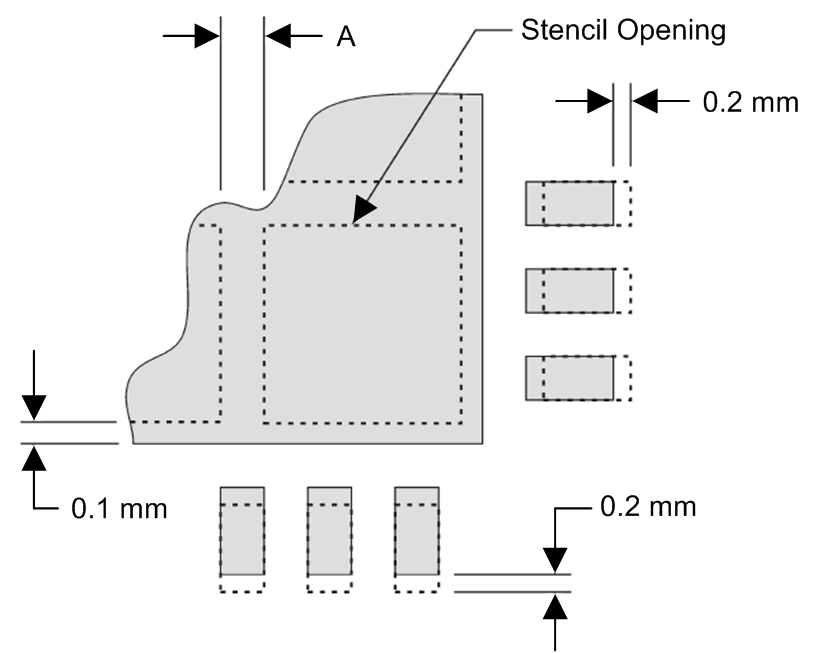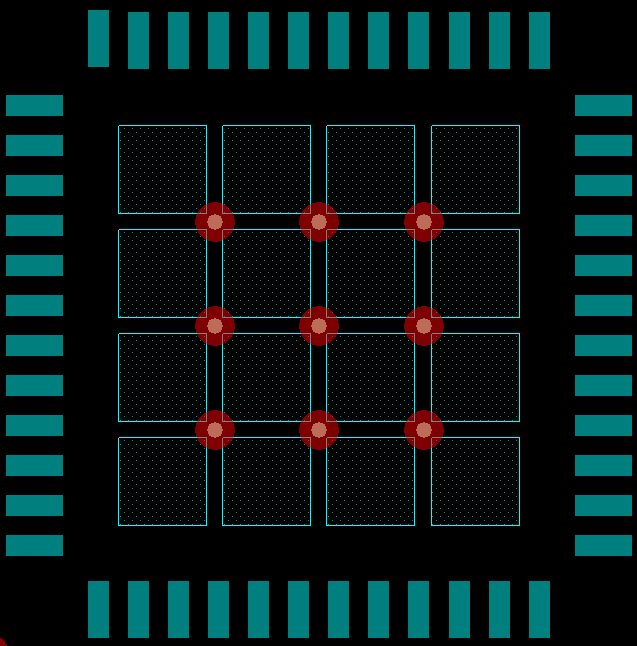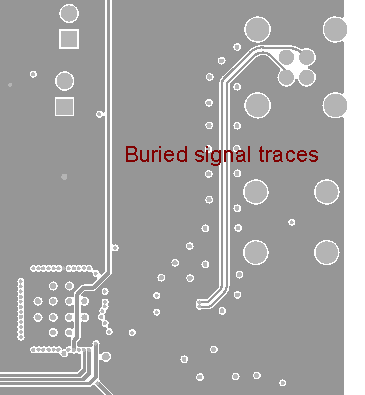SNLS488 March 2016 DS90UB921-Q1
PRODUCTION DATA.
- 1 Features
- 2 Applications
- 3 Description
- 4 Revision History
- 5 Pin Configuration and Functions
-
6 Specifications
- 6.1 Absolute Maximum Ratings
- 6.2 ESD Ratings - JEDEC
- 6.3 ESD Ratings—IEC and ISO
- 6.4 Recommended Operating Conditions
- 6.5 Thermal Information
- 6.6 DC Electrical Characteristics
- 6.7 AC Electrical Characteristics
- 6.8 PCLK Timing Requirements
- 6.9 Recommended Timing for the Serial Control Bus
- 6.10 Switching Characteristics
- 6.11 Typical Charateristics
-
7 Detailed Description
- 7.1 Overview
- 7.2 Functional Block Diagram
- 7.3
Feature Description
- 7.3.1 High Speed Forward Channel Data Transfer
- 7.3.2 Low Speed Back Channel Data Transfer
- 7.3.3 Common Mode Filter Pin (CMF)
- 7.3.4 Video Control Signal Filter
- 7.3.5 EMI Reduction Features
- 7.3.6 LVCMOS VDDIO Option
- 7.3.7 Power Down (PDB)
- 7.3.8 Remote Auto Power-Down Mode
- 7.3.9 Input PCLK Loss Detect
- 7.3.10 Serial Link Fault Detect
- 7.3.11 Pixel Clock Edge Select (TRFB)
- 7.3.12 Frequency Mode Optimizations
- 7.3.13 Interrupt Pins - Funtional Description and Usage (INTB, REM_INTB)
- 7.3.14 Internal Pattern Generation
- 7.3.15 GPIO[3:0] and GPO_REG[7:4]
- 7.3.16 I2S Transmitting
- 7.3.17 Built In Self Test (BIST)
- 7.4 Device Functional Modes
- 7.5 Programming
- 7.6 Register Maps
- 8 Application and Implementation
- 9 Power Supply Recommendations
- 10Layout
- 11Device and Documentation Support
- 12Mechanical, Packaging, and Orderable Information
Package Options
Mechanical Data (Package|Pins)
- RHS|48
Thermal pad, mechanical data (Package|Pins)
- RHS|48
Orderable Information
10 Layout
10.1 Layout Guidelines
Circuit board layout and stack-up for the FPD-Link III devices should be designed to provide low-noise power feed to the device. Good layout practice will also separate high frequency or high-level inputs and outputs to minimize unwanted stray noise pickup, feedback and interference. Power system performance may be greatly improved by using thin dielectrics (2 to 4 mils) for power / ground sandwiches. This arrangement provides plane capacitance for the PCB power system with low-inductance parasitics, which has proven especially effective at high frequencies, and makes the value and placement of external bypass capacitors less critical. External bypass capacitors should include both RF ceramic and tantalum electrolytic types. RF capacitors may use values in the range of 0.01 uF to 0.1 uF. Tantalum capacitors may be in the 2.2 uF to 10 uF range. Voltage rating of the tantalum capacitors should be at least 5X the power supply voltage being used.
Surface mount capacitors are recommended due to their smaller parasitics. When using multiple capacitors per supply pin, locate the smaller value closer to the pin. A large bulk capacitor is recommend at the point of power entry. This is typically in the 50uF to 100uF range and will smooth low frequency switching noise. It is recommended to connect power and ground pins directly to the power and ground planes with bypass capacitors connected to the plane with via on both ends of the capacitor. Connecting power or ground pins to an external bypass capacitor will increase the inductance of the path.
A small body size X7R chip capacitor, such as 0603 or 0402, is recommended for external bypass. Its small body size reduces the parasitic inductance of the capacitor. The user must pay attention to the resonance frequency of these external bypass capacitors, usually in the range of 20-30 MHz. To provide effective bypassing, multiple capacitors are often used to achieve low impedance between the supply rails over the frequency of interest. At high frequency, it is also a common practice to use two vias from power and ground pins to the planes, reducing the impedance at high frequency.
Some devices provide separate power and ground pins for different portions of the circuit. This is done to isolate switching noise effects between different sections of the circuit. Separate planes on the PCB are typically not required. Pin Description tables typically provide guidance on which circuit blocks are connected to which power pin pairs. In some cases, an external filter may be used to provide clean power to sensitive circuits such as PLLs.
Use at least a four layer board with a power and ground plane. Locate LVCMOS signals away from the CML lines to prevent coupling from the LVCMOS lines to the CML lines. Closely-coupled differential lines of 100 Ohms are typically recommended for CML interconnect. The closely coupled lines help to ensure that coupled noise will appear as common-mode and thus is rejected by the receivers. The tightly coupled lines will also radiate less.
Information on the WQFN style package is provided in TI Application Note: AN-1187 (SNOA401).
10.2 Layout Example
Stencil parameters such as aperture area ratio and the fabrication process have a significant impact on paste deposition. Inspection of the stencil prior to placement of the WQFN package is highly recommended to improve board assembly yields. If the via and aperture openings are not carefully monitored, the solder may flow unevenly through the DAP. Stencil parameters for aperture opening and via locations are shown below:
 Figure 33. No Pullback WQFN, Single Row Reference Diagram
Figure 33. No Pullback WQFN, Single Row Reference Diagram
Table 10. No Pullback WQFN Stencil Aperture Summary
| DEVICE | PIN COUNT | MKT Dwg | PCB I/O Pad Size (mm) | PCB PITCH (mm) | PCB DAP SIZE (mm) | STENCIL I/O APERTURE (mm) |
STENCIL DAP Aperture (mm) |
NUMBER of DAP APERTURE OPENINGS |
GAP BETWEEN DAP APERTURE (Dim A mm) |
|---|---|---|---|---|---|---|---|---|---|
| DS90UB921-Q1 | 48 | SQA48A | 0.25 x 0.6 | 0.5 | 5.1 x 5.1 | 0.25 x 0.7 | 1.1 x 1.1 | 16 | 0.2 |
 Figure 34. 48-Pin WQFN Stencil Example of Via and Opening Placement
Figure 34. 48-Pin WQFN Stencil Example of Via and Opening Placement
Figure 35 and Figure 36 PCB layout examples are derived from the layout design of the DS90UB921-Q1EVM Evaluation Board. The graphic and layout description are used to determine proper routing when designing the Serializer board. Figure 35 shows the high speed FPD-Link III traces routed differentially to the connector. The traces are buried in an internal layer with a GND layer and power layer on each adjacent layer. Burying the traces helps reduce emissions, and it is important not to route other high speed signals near these critical signal traces. 100Ω differential characteristic impedance and 50Ω single-ended characteristic impedance traces are maintained as much as possible for both STP and coax applications. For layout of a coax board, 100Ω coupled traces should be used with the DOUT- termination near to the connector.
 Figure 35. DS90UB921-Q1 Serializer Example Layout, Inner Layer
Figure 35. DS90UB921-Q1 Serializer Example Layout, Inner Layer
Figure 36 shows the high speed FPD-Link III traces close to the DOUT± pins. In this case, the AC coupling capacitors are on the opposide side of the board, so there is an additional via that would not be needed if the components were all on the same side. This via, the AC coupling capacitors, the common-mode choke, and the second via (going to the buried traces to the connector) are all place closely together so that the impedance discontinuity appears as tightly grouped as possible.
 Figure 36. DS90UB921-Q1 Serializer Example Layout, Bottom Layer
Figure 36. DS90UB921-Q1 Serializer Example Layout, Bottom Layer